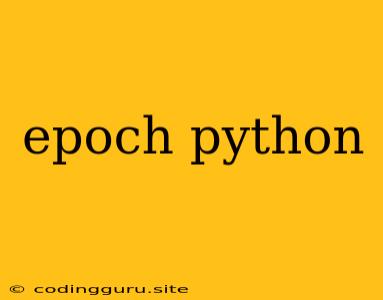Understanding Epoch in Python: A Comprehensive Guide
Have you ever wondered what epoch means in the context of Python programming? It's a fundamental concept related to time and date handling, and understanding it is crucial for working with time-based data.
In essence, the epoch represents a specific point in time from which all timestamps are measured. In the world of Unix and Python, the epoch is defined as January 1, 1970 at 00:00:00 Coordinated Universal Time (UTC).
Let's delve deeper into the concept of epoch and how it's utilized in Python.
What is Epoch in Python?
In simpler terms, the epoch is like a starting point for counting seconds. When we talk about time in Python (or in most Unix-based systems), we refer to it as the number of seconds that have passed since the epoch.
Think of it this way: if you are tracking time with a stopwatch, you start it at 0 seconds. The epoch is like that starting point for your "timekeeping" within a computer system.
Why is Epoch Important?
The epoch is essential because it provides a consistent and standardized way to represent time across different systems and platforms. This consistency is crucial for:
- Storing and retrieving time data: Databases, log files, and other data stores often rely on epoch timestamps for efficient and accurate time tracking.
- Comparing and sorting timestamps: Knowing the number of seconds since the epoch allows for easy comparison and ordering of time-related data.
- Time calculations: The epoch serves as the foundation for performing various time calculations, such as finding the difference between two dates, calculating the duration of an event, or converting timezones.
Working with Epoch in Python
Python provides several built-in functions and modules to work with the epoch and time-related operations:
-
time.time(): This function returns the current time as a floating-point number representing seconds since the epoch.import time current_time = time.time() print(current_time) # Output: A large floating-point number representing seconds since epoch -
datetime.datetime.fromtimestamp(): This function takes an epoch timestamp as input and converts it to a datetime object.import datetime epoch_timestamp = 1677657600 # Example epoch timestamp datetime_object = datetime.datetime.fromtimestamp(epoch_timestamp) print(datetime_object) # Output: 2023-03-01 00:00:00 -
datetime.datetime.timestamp(): This method allows you to convert a datetime object back into an epoch timestamp.import datetime datetime_object = datetime.datetime(2023, 3, 1, 12, 0, 0) epoch_timestamp = datetime_object.timestamp() print(epoch_timestamp) # Output: A large floating-point number representing the epoch timestamp
Examples of Epoch Usage
Here are some practical scenarios where the epoch is used in Python:
-
Logging: When you write to a log file, it's common to include the timestamp using an epoch representation for precise time tracking.
-
Network communication: In network protocols, timestamps are often represented as epoch values to ensure accurate time synchronization between different systems.
-
Data analysis: When working with time series data, you might need to convert dates and times to epoch format for efficient processing and analysis.
-
Web applications: Web applications often rely on the epoch to track user activity, session durations, and other time-sensitive operations.
Conclusion
Understanding the epoch is crucial for anyone working with time and dates in Python. It serves as the foundation for consistent time representation and manipulation, making it an essential concept for various programming tasks. By mastering the epoch concept and its related Python functions, you can work with time data confidently and efficiently.
